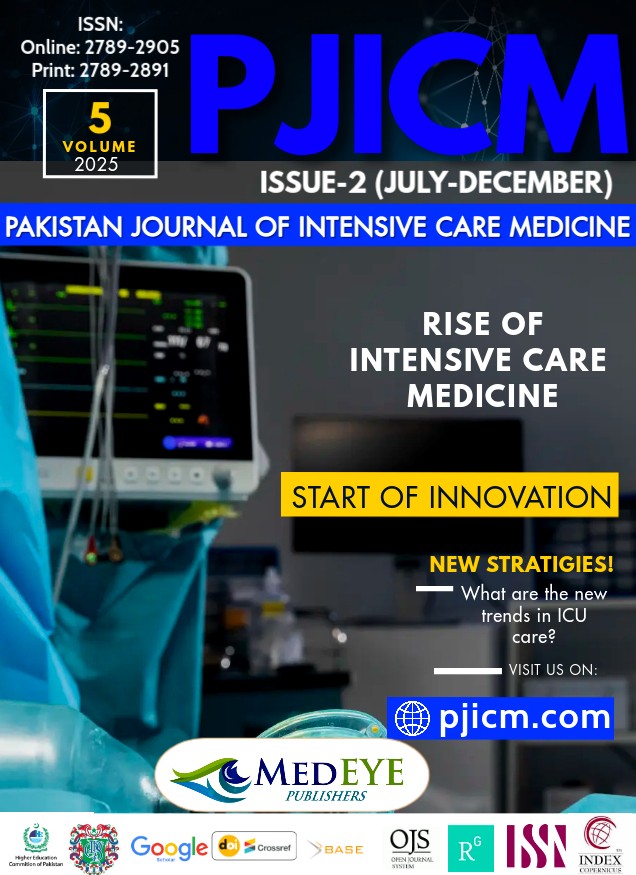POST OPERATIVE COMPLICATIONS OF MODIFIED GRAHM PATCH OMENTOPEXY IN PATIENTS UNDERGOING FOR THE MANAGEMENT OF PERFORATED DUODENAL ULCER
DOI:
https://doi.org/10.54112/pjicm.v5i02.195Keywords:
Duodenal Ulcer Perforation, Modified Graham’s Patch, Omentopexy, Postoperative Complications, Wound Infection, Septic Shock.Abstract
Background: A Perforated duodenal ulcer is a surgical emergency associated with considerable morbidity and mortality. Modified Graham's patch omentopexy is widely used for its management; however, postoperative complications remain an important determinant of clinical outcomes. Objective: To determine the frequency of postoperative complications—wound infection, pneumonia, and septic shock—in patients undergoing modified Graham's patch omentopexy for perforated duodenal ulcer. Study Design: Descriptive study. Setting: Department of Surgery, Mardan Medical Complex, Mardan, Pakistan. Duration of Study: 08 March 2024 to 08 September 2024. Methods: Eighty-three patients with clinical and radiological evidence of perforated duodenal ulcer were included. All underwent modified Graham's patch omentopexy. Postoperative complications (wound infection, pneumonia, and septic shock) were assessed starting from the fifth postoperative day and continued after discharge. Data analysis was performed using SPSS version 25. Descriptive statistics were applied, and associations with age were evaluated at the p ≤ 0.05 significance level. Results: The mean age was 51.83 ± 15.52 years, with males comprising 91.6% (n = 76). Wound infection occurred in 12.0% (n = 10), pneumonia in 4.8% (n = 4), and septic shock in 3.6% (n = 3). Septic shock was more common in patients aged >35 and >50 years (p = 0.05). Conclusion: Wound infection was the most frequent postoperative complication, followed by pneumonia and septic shock after modified Graham's patch omentopexy for a perforated duodenal ulcer. Increasing age was associated with a higher risk of septic shock.
References
Clinch D, Damaskos D, Di Marzo F, Di Saverio S. Duodenal ulcer perforation: a systematic literature review and narrative description of surgical techniques used to treat large duodenal defects. J Trauma Acute Care Surg. 2021;91(4):748–58. https://doi.org/10.1097/TA.0000000000003357
Shen Q, Liu T, Wang S, Wang L, Wang D. Experience in the Diagnosis and treatment of duodenal ulcer perforation in children. BMC Pediatr. 2023;23(1):144. https://doi.org/10.1186/s12887-023-03957-8
Singh LO, Maibam C, Singh TS, Singh SO. A clinical study of duodenal ulcer perforation. J Dent Med Sci. 2020;19(8):07–29. https://doi.org/10.9790/0853-1908050729
Malik M, Magsi AM, Parveen S, Khan MI, Iqbal M. Duodenal ulcer perforation and its consequences. J Pak Med Assoc. 2023;73(7):1506–10. https://doi.org/10.47391/JPMA.4768
Amalia R, Vidyani A, I'tishom R, Efendi WI, Danardono E, Wibowo BP, et al. The prevalence, etiology, and treatment of gastroduodenal ulcers and perforation: a systematic review. J Clin Med. 2024;13(4):1063. https://doi.org/10.3390/jcm13041063
Tarasconi A, Coccolini F, Biffl WL, Tomasoni M, Ansaloni L, Picetti E, et al. Perforated and bleeding peptic ulcer: WSES guidelines. World J Emerg Surg. 2020;15(1):3. https://doi.org/10.1186/s13017-019-0283-9
Ansari D, Torén W, Lindberg S, Pyrhönen HS, Andersson R. Diagnosis and management of duodenal perforations: a narrative review. Scand J Gastroenterol. 2019;54(8):939–44. https://doi.org/10.1080/00365521.2019.1647456
Ogbuanya AU, Eni UE, Umezurike DA, Obasi AA, Ikpeze S. Associated factors of leaked repair following omentopexy for perforated peptic ulcer disease: a cross-sectional study. Arch Acad Emerg Med. 2023;12(1):e18. https://doi.org/10.22037/aaem.v12i1.2169
Tullavardhana T, Chartkitchareon A. Does omental plugging provide a better surgical treatment outcome than the omentopexy technique in the management of giant peptic ulcer perforation? A meta-analysis of comparative studies. Oman Med J. 2022;37(6):e439. https://doi.org/10.5001/omj.2022.61
Abdallah HA, Abd-El-Aal AS. Comparative study between Graham's omentopexy and modified Graham's omentopexy in the treatment of perforated duodenal ulcers. Egypt J Surg. 2018;37(4):485–9. https://doi.org/10.4103/ejs.ejs_61_18
Abouelazayem M, Jain R, Wilson MS, Martinino A, Balasubaramaniam V, Biffl W, et al. Global 30-day morbidity and mortality of surgery for perforated peptic ulcer: GRACE study. Surg Endosc. 2024;38(8):4402–14. https://doi.org/10.1007/s00464-024-10881-0
Mahmoud K, Abou Chaar MK, Stephens D, Zietlow JM, Heller SF, Turay D, et al. Perforated peptic ulcer: to close or patch – a century-old controversy. J Gastrointest Surg. 2025;29(4):101993. https://doi.org/10.1016/j.gassur.2025.101993
Biloslavo A, Mastronardi M, Sandano M, Gabrieli A, Troian M. Laparoscopic treatment for perforated gastroduodenal ulcer: direct repair surgical technique. Ann Laparosc Endosc Surg. 2023;8(1):1–8. https://doi.org/10.21037/ales-23-17
Khare AK, Patel KP, Chopra AK, Goyal P, Paliwal A, Baindur AJ, et al. Graham's patch omentopexy versus modified Graham's patch omentopexy in duodenal perforation – a comparative study. Asian J Med Sci. 2024;15(8):156–61. https://doi.org/10.3126/ajms.v15i8.66487
Kamran F, Shah M, Sheikh IA, Mahmood K, Hassan N. Modified Graham's patch repair versus Graham's patch repair for treatment of perforated peptic ulcer in terms of postoperative morbidity/mortality. Pak Armed Forces Med J. 2022;72(1):323–6. https://doi.org/10.51253/pafmj.v72i1.7500
Abrar M, Farooq MS, Mustafa U, Ahmed A, Inam MW, Raza A. Comparison of modified Graham's patch repair with and without anchoring suture in patients with duodenal ulcer perforation. JCPSP Postgrad. 2025;1(2):127–31. https://doi.org/10.29271/jcpsppg.2025.02.127
Arora BK, Arora R, Arora A. Modified Graham's repair for peptic ulcer perforation: reassessment study. Int Surg J. 2017;4(5):1667–71. https://doi.org/10.18203/2349-2902.isj20171618
Shreya A, Sahla S, Gurushankari B, Shivakumar M, Rifai, Kate V, et al. Spectrum of perforated peptic ulcer disease in a tertiary care hospital in South India: predictors of morbidity and mortality. ANZ J Surg. 2024;94(3):366–70. https://doi.org/10.1111/ans.18831
Deb PP, Sarkar AN. Prospective study comparing Graham's omental patch with modified Graham's patch in the management of perforated duodenal ulcer. Sch J App Med Sci. 2019;7(3):1305–8.
Al-Asadi OG, Baqir QK, Alnajjar IM. Novel technique for the placement of omental patch during repair of perforated duodenal ulcer: a retrospective study of prospectively collected data. Surg Gastroenterol Oncol. 2024;29(2). https://doi.org/10.21614/sgo-663
Downloads
Published
How to Cite
Issue
Section
License
Copyright (c) 2025 . SIDRA, A KHAN , WU RAHMAN , S HASSAN , ZY KAUSAR

This work is licensed under a Creative Commons Attribution-NonCommercial 4.0 International License.












